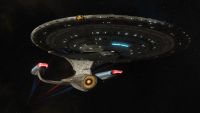Ross Class
| STARSHIP | |
|---|---|
 | |
| Class | Ross-class |
| Allegiance | United Federation of Planets |
 | |
| Specifications | |
| Type: | Exploration Cruiser (EC) |
| Length: | 663.2 Meters |
| Beam: | 398.9 Meters |
| Height: | 146.8 Meters |
| Mass: | 4,409,556.7 Metric Tons |
| Decks: | 42 Deck Plans |
| Crew Compliment: | Standard: 250 Officers, 600 Enlisted plus civilian specialists and families. Emergency: 6,000 |
| Warp Speed: | Main Core: Cruise Speed: 7.0 Sustainable Speed: 9.0 Emergency Speed: 9.2 (12 hour automatic shutdown) Auxiliary Core: |
| Impulse Engines: | Type: 3 Class 8 Main Impulse Engines (MIE) Speed: .85 C |
| Defensive Systems: | Type-1A Shield generator |
| Other Defensive Systems: | 30cm Ablative Armour |
| Armament: | Phasers: Dorsal 1x 270-degree Type-XI Array(Saucer); Ventral 1x 270-degree Type-XI Array (Saucer); Lateral 2x 60-degree Type-XI Arrays, one starboard, one port(Pylons); Ventral 1x 60-degree Type-XI Array (Secondary Hull); Torpedoes: 3x Rapid-Fire Photon Torpedo Tubes (2F/1A) Payload: 500 Photon Torpedoes. |
| Computer System: | Yori-Moto D4D019 |
| Tractor/Repulsor: | 2 Main Tractor/Repulsor Beams, 7 Shuttle-Docking Tractors 6 Docking Tractors |
| Shuttlecraft: | 1 Bay (A), 16 Shuttles (8 Type 18, 8 Type 14), 4 Runabouts (Delta Class) |
| Sensors: | SS Sierra 1a8 Deep Space Scientific Sensors Daystrom Industries HSCS-3SC-A Starship Sensors |
The USS Ross is a starship designed as part of the Fleet Modernization Program as an alternative to the Andromeda Class Exploration Cruiser. It is currently in service as a testbed for new and experimental Science and Engineering systems. The USS Ross is named for Mary G. Ross, the first known Native American female engineer.
History
The Galaxy III project was actually one of the proposed designed for the initial Galaxy-Class refit, the Galaxy II during the mid-2370s. Rejected at the time, Dr. Jeremiah's Quick's three-nacelled variant became the operating model during the wars of the late 24th century. However, after in the nearly three years since the Galaxy herself was refitted to those specifications, it has become clear that the Quick design was not without it's flaws.
Work continued on the proposed design even while the Galaxy II was still in refits. This work never bore fruit, however, as Star Fleet eventually turned its focus towards warships with science facilities rather than science vessels with warfighting capabilities. The design languished in a desk drawer somewhere at the Star Fleet Corps of Engineers until mid-2418, when the failure of the Beckett-class required an immediate replacement for deep-space exploration within the Alpha and Beta Quadrants.
Pulled from Qualor II at the same time as the USS Andromeda, the Ross was based on a competing design by the Tellarite engineer Doctor Debluch Marrone. A more extensive retrofit than the Andromeda, the hull structure was significantly altered to allow for anticipated breakthroughs in scientific and engineering systems. The rebuild was beset by delays, and the Andromeda was the first ship out of the construction yards; being awarded the contact for full production. Rather than scrap the nearly-complete Ross, Star Fleet instead decided to finish her and utilise her as a testbed for the newest and most experimental systems. Finally completed six months behind schedule, the Ross launched in mid-2421.